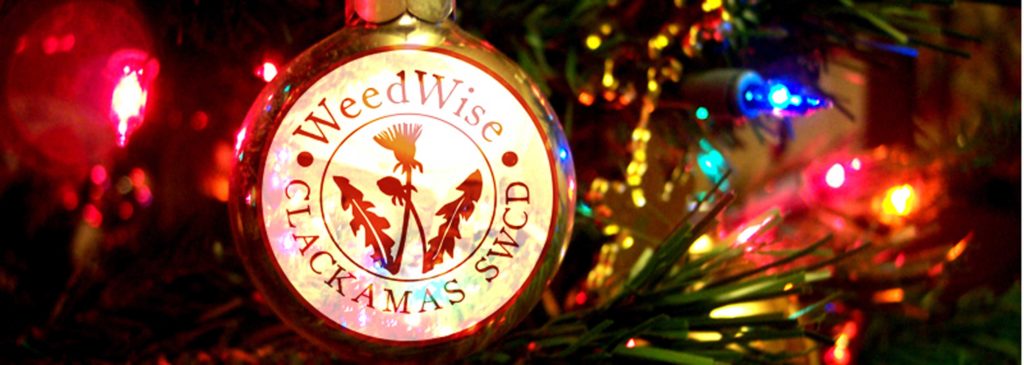We’ve been making a list,
And checking it twice,
Now its time to find out
Who has been naughty and nice!
It is a WeedWise tradition for each of our staff to select our annual “Naughty and Nice” plants for the year. Check out the latest from our staff in this fun holiday tradition!
Happy Holidays!
Sam’s Naughty and Nice List
Naughty: Meadow Knapweed (Centaurea × moncktonii)
Meadow knapweed made my “Naughty List” this year because of its impacts on our native grassland communities and on hay and pasturelands. The knapweeds, in general, are all very invasive in our area, and closely related species like spotted and diffuse knapweed are also very problematic. Meadow knapweed, in particular, seems to do quite well in Clackamas County and continues to spread.
The knapweed can be difficult to distinguish, but if you look closely at the bracts at the base of the flower you can identify them. Meadow knapweed is very distinctive in that it has bristled brown bract on large and showy flower heads.
If you have meadow knapweed growing on your property, I encourage you to begin controlling it to preserve our native grasslands systems and to help protect our local hay and livestock producers. It is not too late for us to take real action to stop and slow the invasion of Meadow Knapweed.
So deliver a lump of coal to this noxious weed!
You can learn more about meadow knapweed on the WeedWise profile page!
Nice: Common Camas (Camassia quamash)
Camas is on my “Nice List” because frankly it always makes me happy when I see it! I started my professional career working in Willamette Valley prairies, and camas often serves as an indicator of a site that has a prairie or grassland-like past. So, whenever I come across camas in the field, I am immediately reminded of the good people I have worked with over the years as well as the natural beauty and ecology of the Willamette Valley.
The sight of camas also reminds me of the important connection between people and the land. Camas was an important food for indigenous peoples and was—and is—actively managed and cultivated throughout our region. This long-standing connection between camas and people reminds me of the importance of protecting our natural systems. We are part of—and ultimately connected to—these natural systems in a way that our modern lives often obfuscate. Camas is a reminder of that connection for me.
If that isn’t enough of a reason to put camas on our nice list, then the sheer beauty of these plants should change anyone’s mind. The bright blue/purple flowers put on an amazing show, especially when they are in numbers. Here in Clackamas County, we are graced with one of the better camas displays each spring at Camassia Park in West Linn. If you haven’t seen this spring display, it is well worth the trip. Just remember to #PlayCleanGo by cleaning your shoes to prevent the introduction of invasive weeds!
Learn more about camas at the Oregon Encyclopedia link!
Naughty: Scotch broom (Cytisus scoparius)
Scotch broom is a big problem in our area making it an easy candidate for our Naughty list. Scotch broom is one of our most common invaders. It was originally introduced as an ornamental plant but has since proven to be highly invasive. A recent study found that Scotch broom accounted for personal income losses of $39.5 million per year to Oregonians. That is a lot of reasons to serve up a lump of coal to Scotch broom this holiday season!
When Scotch broom does invade it crowds out our native and desirable plants. In forestry settings, it is incredibly problematic. It can reduce natural regeneration and stunts the growth of desirable tree species. Scotch broom is known to greatly increase the risk and intensity of fire. With the horrible and tragic series of wildfires this past year, this should be a big concern for any homeowner with Scotch broom on their property.
To learn more about the management of Scotch broom check out the WeedWise Best Management Practices page.
Nice: Oceanspray (Holodiscus discolor)
Oceanspray is a great species for inclusion on our “Nice List” this year. This showy native plant is a great addition to any landscape.
Also known as “ironwood”, oceanspray has extremely hard wood that was used traditionally for roasting forks, hooks, spears, and arrow shafts. Pegs made of oceanspray were even used as nails! In addition to all of these uses, oceanspray also serves as quality habitat for birds and other wildlife. So consider oceanspray as a great addition to any backyard habitat.
Learn more about oceanspray by following the link.
Naughty: Orange hawkweed (Hieracium aurantiacum)
Orange hawkweed is on my “naughty” list because it can invade some of my favorite places, like pristine mountain meadows. And as a Class A Noxious Weed, it’s a high priority in Oregon.
Nice: Scarlet paintbrush (Castilleja miniata)
Scarlet paintbrush is on my “nice” list because it grows in mountain meadows amidst a host of beautiful wildflowers. Plus, it’s just a really interesting plant because it’s semi-parasitic, and the red flower “petals” are actually not all petals, most of them are bracts
Courtney’s Naughty and Nice List
Naughty: Policeman’s helmet (Impatiens glandulifera)
Thankfully, hand removal efforts are relatively easy due to its shallow roots. Mowing is also a feasible control method if seed heads are removed before treatment.
You can find more information on Policeman’s helmet on the Clackamas Soil & Water Conservation District’s website. It was featured as this year’s June Invasive Weed of the Month!

